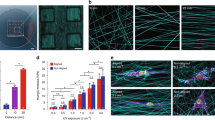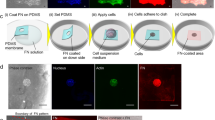Abstract
Migrating cells in vivo monitor the physiological state of an organism by integrating the physical as well as chemical cues in the extracellular microenvironment, and alter the migration mode, in order to achieve their unique function. The clarification of the mechanism focusing on the topographical cues is important for basic biological research, and for biomedical engineering specifically to establish the design concept of tissue engineering scaffolds. The aim of this study is to understand how cells sense and respond to the complex topographical cues in vivo by exploring in vitro analyses to complex in vivo situations in order to simplify the issue. Since the intracellular mechanical events at subcellular scales and the way of the coordination of these events are supposed to change in the migrating cells, a key to success of the analysis is a mechanical point of view with a particular focus of the subcellular mechanical events. We designed an experimental platform to explore the mechanical requirements in a migrating fibroma cell responding to micro-grooves. The micro-grooved structure is a model of gap structures, typically seen in the microenvironments in vivo. In our experiment, the contributions of actomyosin force generation can be spatially divided and analyzed in the cell center and peripheral regions. The analysis specified that rapid leading edge protrusion, and the cell body translocation coordinated with the leading edge protrusion are required for the turning response at a micro-groove.
Similar content being viewed by others
References
P. Friedl and K. Wolf, J. Cell Biol., 2010, 188, 11.
M. P. Lutolf and J. A. Hubbell, Nat. Biotechnol., 2005, 23, 47.
N. A. Kurniawan, P. K. Chaudhuri, and C. T. Lim, J. Biomech., 2016, 49, 1355.
K. Wolf and P. Friedl, Trends Cell Biol., 2011, 21, 736.
H. Miyoshi and T. Adachi, Tissue Eng. Part B, 2014, 20, 609.
A. D. Doyle and K. M. Yamada, Exp. Cell Res., 2016, 343, 60.
J. Nakanishi, Chem.-Asian J., 2014, 9, 406.
A. Ueki and S. Kidoaki, Biomaterials, 2015, 41, 45.
G. Charras and E. Sahai, Nat. Rev. Mol. Cell Biol., 2014, 15, 813.
G. Totsukawa, Y. Wu, Y. Sasaki, D. J. Hartshorne, Y. Yamakita, S. Yamashiro, and F. Matsumura, J. Cell Biol., 2004, 164, 427.
G. Totsukawa, Y. Yamakita, S. Yamashiro, D. J. Hartshorne, Y. Sasaki, and F. Matsumura, J. Cell Biol., 2000, 150, 797.
M. L. Gardel, I. C. Schneider, Y. Aratyn-Schaus, and C. M. Waterman, Ann. Rev. Cell Dev. Biol., 2010, 26, 315.
A. del Rio, R. Perez-Jimenez, R. C. Liu, P. Roca-Cusachs, J. M. Fernandez, and M. P. Sheetz, Science, 2009, 323, 638.
R. Janostiak, A. C. Pataki, J. Brabek, and D. Rosel, Eur. J. Cell Biol., 2014, 93, 445.
T. Vallenius, Open Biol., 2013, 3, 130001.
Acknowledgments
This work was partially supported by PRIME. AMED. and a Grant for Facilitation of Innovation Processes from RIKEN Baton Zone Programs Office. We also thanks the RIKEN BOCC for confocal microscopy.
Author information
Authors and Affiliations
Corresponding author
Electronic supplementary material
Rights and permissions
About this article
Cite this article
Miyoshi, H., Suzuki, K., Ju, J. et al. A Perturbation Analysis to Understand the Mechanism How Migrating Cells Sense and Respond to a Topography in the Extracellular Environment. ANAL. SCI. 32, 1207–1211 (2016). https://doi.org/10.2116/analsci.32.1207
Received:
Accepted:
Published:
Issue Date:
DOI: https://doi.org/10.2116/analsci.32.1207




